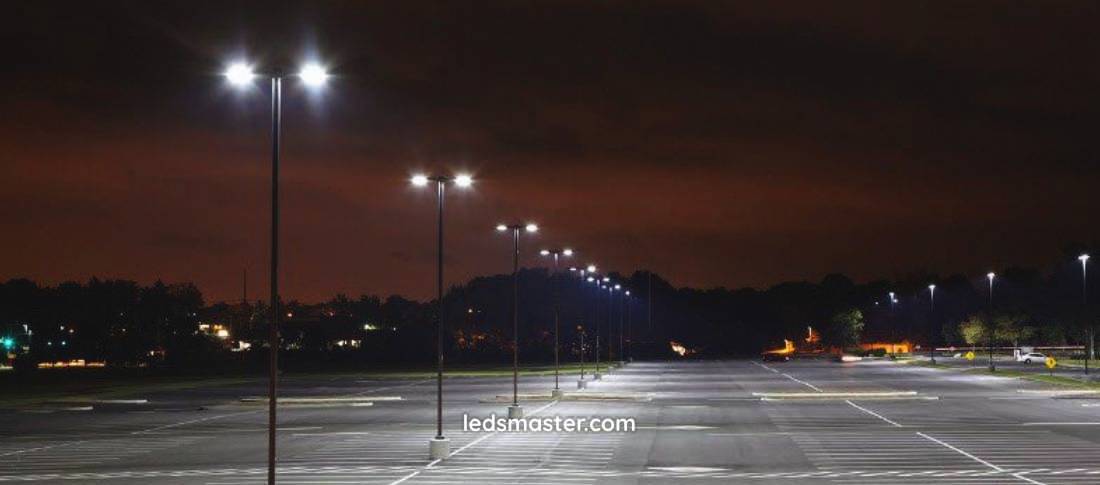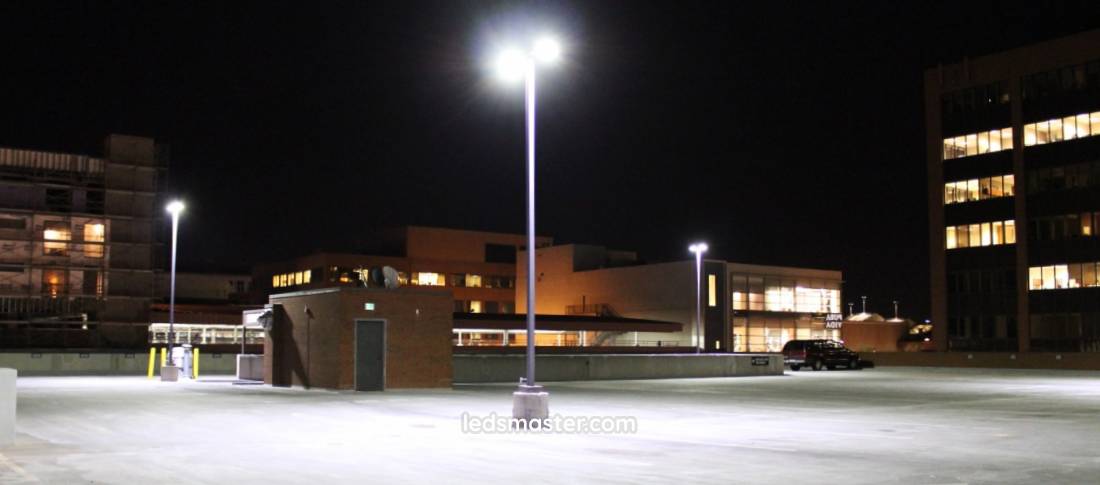Picture a dimly lit parking lot where shadows obscure pathways and visibility is compromised. Effective lighting transforms these spaces into safe, welcoming environments. Thoughtful lighting design enhances security and accessibility while addressing glare, energy efficiency, and environmental impact.
Get your complimentary lighting design today
Designing effective lighting for parking lots is about more than just providing visibility; it’s a blend of safety, functionality, and environmental awareness. Industry standards, like those set by the Illuminating Engineering Society (IES), outline recommended practices for lighting levels, fixture placement, and uniformity to enhance user safety and comfort. By following these guidelines, designers can create well-lit spaces that not only improve navigation and security but also minimize glare, reduce light pollution, and contribute to a sustainable urban environment.
Table of Contents
ToggleSeveral industry standards and regulations apply to parking lot lighting design. The Illuminating Engineering Society (IES) offers guidelines to determine minimum and maximum lighting levels, uniformity ratios, and other technical criteria to create safe and efficient lighting plans. In the United States, the IES provides the recommended practice (RP-20) specifically for parking facilities, addressing aspects such as light distribution, intensity, and uniformity. Compliance with these standards promotes safety, reduces potential hazards, and fosters a consistent lighting quality across facilities.
Standards recommend specific illumination levels, measured in foot-candles or lux, to ensure visibility without over-lighting. In general, parking lots may require lower levels of illumination compared to high-traffic areas, although security zones or walkways may need brighter lighting for added safety. Typical lighting levels range from 1 to 5 foot-candles in most parking facilities. Clear guidelines allow designers to achieve the appropriate brightness without creating glare, dark spots, or excessive shadows.
Uniformity in lighting ensures that visibility is consistent across the parking lot, avoiding dark spots where pedestrians may feel less secure or vehicles may have difficulty navigating. Uniformity ratios help achieve balanced illumination by comparing the brightest and darkest areas within the lot. Ratios between 3:1 and 4:1 are often recommended for general parking areas. Additionally, reducing glare is crucial for driver and pedestrian comfort. Techniques such as fixture shielding, angle adjustments, and proper placement contribute to glare reduction, enhancing the experience for users.

Light pollution is an environmental concern that many parking lot lighting designs seek to address. Directing light downward, using shields on fixtures, and avoiding excessive brightness help limit light trespass and skyglow. Dark Sky-compliant fixtures and practices support this effort, minimizing impacts on neighboring properties, wildlife, and night-sky visibility.
Pole-mounted fixtures provide broad coverage and are typically the primary choice for illuminating parking areas. These fixtures are mounted at various heights, depending on the parking lot’s size and the desired illumination level. Higher poles can reduce the number of fixtures needed but may increase glare, so careful consideration of pole height, placement, and light distribution is essential. Pole-mounted lights are suitable for general illumination, as they offer sufficient spread to cover large areas with minimal obstruction.
Wall-mounted fixtures supplement lighting in areas close to buildings or near entrances and exits. They provide additional security by illuminating building perimeters and reducing dark zones. These fixtures are usually mounted at lower heights than pole lights, enhancing visibility around pathways, stairways, and access points. Wall-mounted lights also help reduce the risk of vandalism and intrusion in areas where surveillance is limited.
Bollard lights are low-level fixtures that line walkways and pedestrian paths, often in parking lots adjacent to commercial properties or parks. Positioned at ground level, these lights provide directional lighting that guides pedestrians while minimizing upward light spill. Bollard lights are effective for creating safe walking paths without overwhelming nearby areas with excessive brightness.
Floodlights are high-intensity fixtures used to illuminate specific areas that may require brighter lighting, such as loading zones, entry points, or high-security areas. Although they provide powerful illumination, floodlights must be carefully positioned and shielded to prevent excessive glare and light trespass. When used appropriately, floodlights enhance visibility for both pedestrians and drivers while ensuring the desired areas receive sufficient lighting.
Parking lot lighting systems should be designed to facilitate easy access for maintenance teams. Installing fixtures that are easy to reach and replace reduces downtime and operational costs. Additionally, choosing lights with a long lifespan, such as LEDs, reduces the frequency of replacements, supporting smoother operations and minimizing disruptions for facility users.
Understanding the expected lifespan and replacement costs of fixtures informs budget planning for maintenance and long-term expenses. LEDs offer extended lifespans and lower maintenance requirements, making them a cost-effective choice. Factoring in these costs helps ensure reliable operation while minimizing financial burdens over time.
Regular maintenance and monitoring schedules help keep lighting systems functional and efficient. Inspections, cleaning, and timely replacement prevent issues such as dark spots, flickering, or malfunctioning fixtures. Monitoring systems also allow for early detection of failures, helping facility managers maintain consistent lighting quality and reduce unexpected maintenance needs.

Different areas within a parking lot can require varied lux levels based on their purpose and traffic. For example, high-traffic zones, entrances, exits, and pedestrian areas often need higher lux levels to ensure visibility. These levels help prevent accidents and enhance safety, especially during nighttime use. Balancing lux levels also helps to avoid over-lighting areas, which can contribute to glare and energy inefficiency.
Uniformity in lux distribution ensures a consistent lighting experience across the parking lot, reducing dark spots and shadows. Properly spacing fixtures, selecting optimal pole heights, and adjusting angles contribute to an even spread of light. Overlapping beams from adjacent fixtures help smooth transitions between lit and dimmer areas, enhancing overall visibility and security.
Parking lot lighting often falls within the range of 3000K to 5000K. Warmer color temperatures, around 3000K to 3500K, provide a yellowish light that can create a welcoming and comfortable ambiance, often chosen for residential or low-traffic areas. However, warmer temperatures may not offer the same clarity as cooler tones, which are more common in commercial and high-use spaces. Neutral color temperatures, typically between 3500K and 4000K, strike a balance, offering a moderate tone that is less intense than cool white but sufficiently bright for most uses. Cool white to daylight ranges, between 4000K and 5000K, are frequently used in parking lots for enhanced visibility and a sense of security. Cooler lighting enhances clarity, which helps drivers and pedestrians navigate with greater ease and confidence, especially in larger or busier lots.
Color temperature selection can influence user perception of safety and the effectiveness of the lighting for navigation. Cooler color temperatures, around 4000K to 5000K, are generally preferred for parking lots due to the enhanced visibility they provide, making it easier for users to discern details and identify potential obstacles. This level of clarity is beneficial for both pedestrian and driver navigation and supports a sense of security. In contrast, warmer color temperatures may evoke a comfortable ambiance but may not achieve the same visibility, especially in large or complex lots. When designing lighting for parking lots, cooler color temperatures are often chosen for their practical benefits, supporting a safer and more efficient environment for all users.
Pole height and spacing play a major role in achieving even illumination across the parking lot. Higher poles generally cast light over a wider area, reducing the number of fixtures required, but they also produce a higher level of glare if not properly shielded. Typical parking lots use pole heights ranging from 20 to 30 feet, depending on the lot’s size and layout. Closer spacing may be necessary to maintain uniformity, especially in high-traffic or pedestrian-heavy zones.

Dark spots and shadowed areas create potential hazards and reduce security. A thoughtful layout that avoids such areas enhances safety for both pedestrians and drivers. Placing lights around the perimeter, near entrances, and in corners of the lot helps eliminate shadowed zones. Additionally, designing with overlapping beams from adjacent fixtures provides smoother transitions between illuminated and darker areas, reducing sudden drops in visibility.
Perimeter lighting is equally as valuable as central lighting for creating a sense of security and discouraging unwanted activity. Parking lot perimeters may have lower lighting requirements than central areas but should still be well-lit to ensure safe access. Properly balanced lighting throughout the lot ensures that no part of the area feels isolated or underlit, contributing to an overall cohesive lighting environment.
Managing glare and light trespass is essential for creating a comfortable environment for drivers, pedestrians, and surrounding properties. Shielded fixtures direct light downward and reduce the chances of light spilling into unwanted areas. Careful attention to fixture angles and heights helps prevent harsh glare that can obscure vision or create discomfort for users. By managing these elements, designers create a lighting system that prioritizes visibility without overextending light beyond the parking lot boundaries.
Reducing light pollution benefits the environment, local wildlife, and neighboring properties. Downward-facing fixtures and shields prevent unnecessary light spill, while lower color temperatures reduce skyglow. Light pollution can disrupt ecosystems, and parking lot lighting designs that incorporate these techniques support both environmental and community goals.
Dark Sky standards aim to limit the negative impacts of artificial light on the night sky. Fixtures with downward shielding, low color temperature options, and dimming controls support Dark Sky compliance. These measures also benefit neighboring properties by reducing light trespass and minimizing interference with natural lighting patterns, supporting a more sustainable design.
Excessive artificial light can disturb local ecosystems, affecting wildlife behavior and habitat. Birds, nocturnal animals, and insects are sensitive to unnatural light patterns, which can interfere with their migration, feeding, and reproduction cycles. Lighting designs that limit upward and horizontal spill reduce the ecological impact on nearby habitats, supporting biodiversity and environmental health.
A well-designed parking lot lighting system enhances safety, visibility, and energy efficiency while minimizing environmental impact. By following industry standards, designers can ensure consistent lighting quality, reduce unnecessary light spill, and support ecological health. Thoughtful application of these guidelines creates parking areas that are both functional and environmentally responsible.